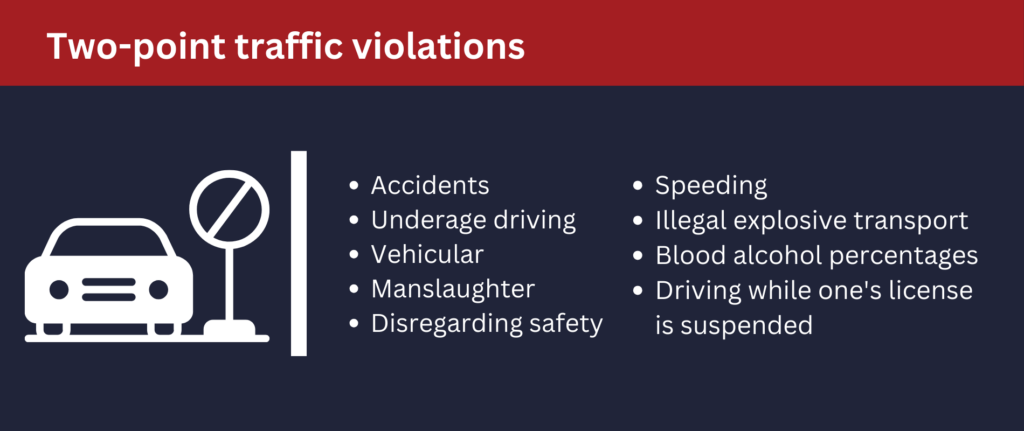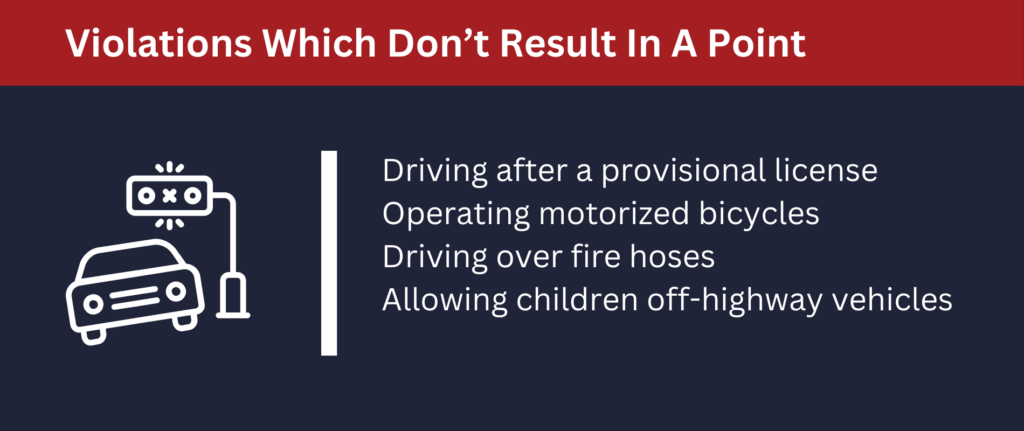
Drivers in California can see their driver’s license suspended for six months if they accumulate too many Negligent Operator Points. These points are assigned when you are convicted of a traffic violation involving the safe operation of a motor vehicle.
Those with class C licenses can get their license suspended for six months if they accumulate four points in one year, six points in two years or eight points in three years.
Those with class A or B licenses are allowed more points before their licenses are suspended: six points in one year, 8 points in two years or 10 points in three years. However, these extra point totals don’t apply to drivers of hazardous materials, general public paratransit, youth buses, tour buses, farm labor, school pupil activity buses, school buses or ambulances.
Those with class A or B licenses can also see their licenses suspended for six months if they accumulate four points in one year, six points in two years or eight points in three years while driving a vehicle that only requires a class C or M license.
For more details about license point violations to look out for, read on.
List Of License Points By Violation
California Vehicle Code 12810 establishes how many Negligent Operator Points are assigned for each moving violation.

Two-point traffic violations:
- CVC 20001 and 20002: Failing to stop for an accident that injures someone or causes property damage
- CVC 23152 and 23153: Driving while under the influence of drugs or alcohol
- PC 191.5 (b): Vehicular manslaughter while intoxicated
- PC 192 (c): Vehicular manslaughter
- CVC 2800.2: Driving with a wanton or willful disregard for safety while trying to escape a pursuing peace officer
- CVC 2800.3: Injuring or killing someone while trying to escape a pursuing peace officer
- CVC 21651 (b): Driving on the wrong side of a highway
- CVC 22348 (b): Driving on a highway at a speed of over 100 miles per hour
- CVC 23109 (a) and (c): Engaging in a motor vehicle speed contest or a motor vehicle exhibition of speed on a highway
- CVC 23109.1: Injuring someone while engaging in a motor vehicle speed contest
- CVC 31602: Illegally transporting explosives
- CVC 23140 (a) and (b): Driving with a blood alcohol percentage over 0.05 while under the age of 21
- CVC 14601: Driving while your driving privilege is suspended or revoked
One point is assigned when you violate CPC 23123 or 23123.5 by driving while using a cell phone or texting for the second time in three years.
Every other traffic conviction involving the safe operation of a motor vehicle on the highway is assigned one point. Examples of one point traffic offenses include:
- Speeding
- Not following traffic signs or signals
- Running a red light
- Running a stop sign
- Failure to yield the right of way
- Illegal turns
- Unsafe lane changes

Those who are not the owner of the vehicle they are driving when they are convicted of the following offenses are not assigned a point:
- Driving an unregistered vehicle, or a vehicle whose registration fee has not been paid
- Driving a vehicle not equipped as required by vehicle code
- Driving a vehicle that isn’t in compliance with the size, weight and load provisions in the vehicle code
- Driving a vehicle that isn’t in compliance with vehicle code regulations, or city/county ordinances
- Driving a vehicle that isn’t in complaince with smog check regulations
Getting into an accident, such as a car accident or motorcycle accident, which is deemed your fault results in one point being assigned.
Violating CVC 27360 or 27360.5 results in one point being assigned. You violate these codes when you:
- Transport a child under the age of eight, on a highway, who is not properly secured in a rear seat in an appropriate child passenger restraint system that meets federal standards
- Transport a child under the age of two, on a highway, who is not properly secured in a rear-facing child passenger restraint system that meets federal standards, unless the child is over 40 pounds or 40 inches tall
Violations Which Don’t Result In A Point

The following traffic violations do not result in a Negligent Operator Point:
- CVC 12814.6 (b), (1) and (2): Driving during the first 12 months after the issuance of a provisional license between the hours of 11 PM and 5 AM, or while transporting passengers under 20 years old
- CVC 21116: Driving a vehicle upon a public canal bank, levee, pipeline right-of-way, or natural watercourse bank
- CVC 21207.5: Operating a motorized bicycle or class 3 electric bicycle on a recreational trail, hiking trail, equestrian trail, bicycle lane, bikeway, bicycle trail or bicycle path
- CVC 21708: Driving over a fire hose or chemical hose used by a fire department
- CVC 21710: Coasting downhill on a highway with your gears in neutral
- CVC 21716: Operating a golf cart on a highway where the speed limit is over 25 miles per hour
- CVC 23120: Driving while wearing glasses that interfere with lateral vision
- CVC 24800: Driving with your parking lamps lighted
- CVC 26707: Driving without your windshield wipers maintained in good operating condition
- CVC 21712: Letting people ride on parts of vehicles not intended for passengers, in your trunk, towing a trailer, which isn’t designed to carry a passenger, with someone inside, or towing a motorcycle, motorized bicycle, bicycle, coaster, roller skater, sled, skiier or toy vehicle
- CVC 23136: Driving with a blood alcohol percentage over 0.01 but under 0.05 while under the age of 21
- CVC 38301: Driving where not allowed on public lands
- CVC 38301.3: Driving where not allowed in federal or state wilderness areas
- CVC 38301.5: Driving where not allowed in a mountain fire district
- CVC 38304.1: Allowing a child to operate an off-highway motor vehicle if they can’t reach and operate all controls necessary to safely operate it
- CVC 38504.1: Allowing an unauthorized child to operate an all-terrain vehicle, or allowing an authorized child to operate an ATV without the direct supervision of an adult
How Long Do License Points Stay On My Record?
One point offenses stay on your record for three years.
Some two point offenses, such as driving over 100 miles per hour, stay on your record for seven years.
Most two point offenses, like DUI, stay on your record for 10 years.
California Drivers License Points: How Many Points Lead to License Suspension?
Accumulating too many points can lead to the suspension of your driver’s license. The DMV will consider you a negligent operator and will have your driver’s license suspended for six months if you accumulate.
- Four points within one year
- Six points within two years
- Eight points within three years
Points and Teen Drivers
California’s point system for violations is very strict when it comes to young drivers. Receiving two points within 12 months as a teen driver can lead to a 30-day restricted license. If a teen driver accumulates three points or more during any one year, they face a six-month suspension and one-year probation.
Points and Commercial Drivers
California takes a tough stance on moving violations for commercial vehicle drivers. A violation by a commercial driver is subject to 1.5 times the number of points given to the average driver for the same violation. In this case, a commercial driver will receive three points for a two-point violation. Likewise, commercial vehicle drivers can accumulate two more points before facing a license suspension.
How Can I Mask Points From My Record?
California allows you to mask the points for one moving violation infraction (not misdemeanor or felony) every 18 months by completing a California DMV-approved traffic school program. These points will not show on your public record, will not be assigned to your DMV record, and your insurance company will not be told about them.
The Best Way to Avoid Gaining Points
California driver’s license points can lead to serious complications. The best way to avoid accumulating points is to practice safe driving and adhere to the rules.
In addition to giving you points on your license, unsafe driving could lead to car accidents. Since California is a fault state, the at-fault party is liable for the damages of anyone injured in the accident. If you believe the crash was a result of another party’s negligence, remember to file a claim before the statute of limitations expires. If you’ve been involved in an accident, a lawyer can help you receive the compensation you deserve. Contact our legal team for a free case evaluation today.

